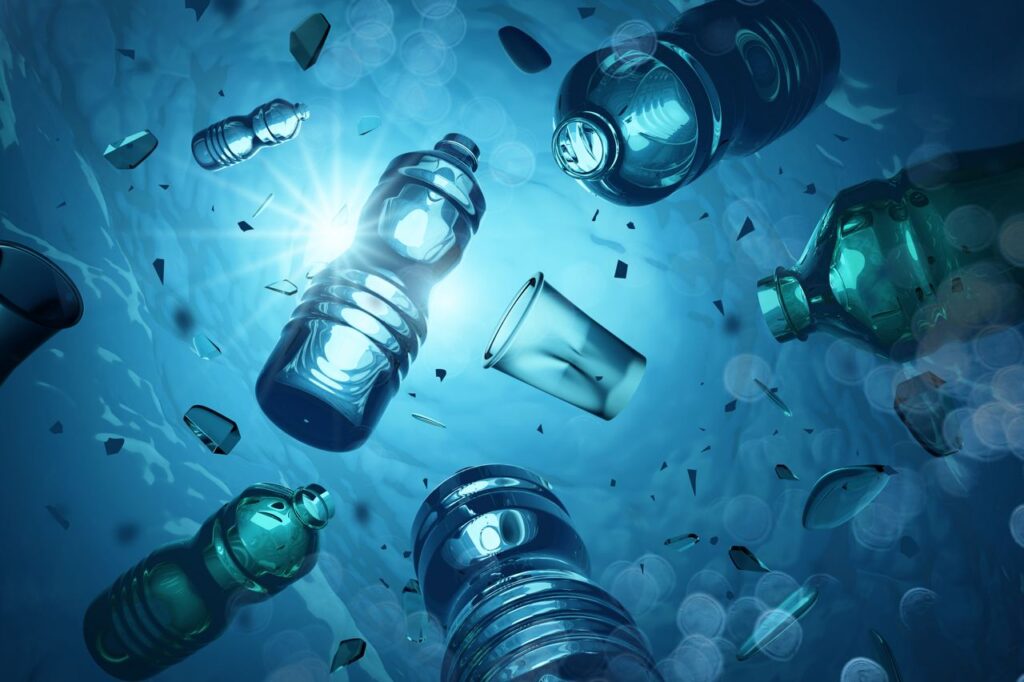It can be found in food packaging, drinks cans, building materials, drinking water pipes, toys or kitchen utensils made from recycled PVC. It can even be found in the supermarket checkout receipts made from the soft-touch thermal paper we leave crumpled at the bottom of our bags.
Polyvinyl chloride (PVC) has been used for decades in the manufacture of many everyday products, but this versatile plastic hides an open secret that has been known to scientists and regulators for years: it contains a wide range of chemicals that are hazardous to health and have been linked to endocrine disruption, cancer, and heart disease.
The adverse health effects of these additives have been known for decades, particularly in the case of bisphenol A (BPA), one of the most studied chemicals used in PVC, which has been identified as a phytoestrogen. Yet more than one million tonnes of BPA are produced or imported each year in the European Union, according to the Registration, Evaluation, Authorisation and Restriction of Chemicals (REACH) Regulation.
The European Commission is committed to restricting PVC and its additives, as set out in its roadmap for restrictions adopted in October 2020. It has already asked the European Chemicals Agency (ECHA) to prepare a report on the risks associated with PVC, which is due to be published shortly, after which the Commission will decide whether to proceed with the restriction proposal and what its scope will be. In this context, dozens of European civil society organisations are mobilising to urge the Commission to speed up the ban process.
Decades of scientific evidence point to a “potential health risk for millions of people”.
Numerous scientific articles demonstrate the harmful effects of certain types of plastics and microplastics on both health and the planet. According to an editorial in The Lancet in June 2023, of all these health risks, endocrine disruption is the most studied. Endocrine disruption is caused by chemicals such as phthalates, perfluoroalkyl substances, bisphenol A and flame retardants, which are particularly prevalent in type 3 plastics such as polyvinyl chloride (PVC).
According to The Lancet, they are “linked to a wide range of health effects, from endometriosis and breast cancer to heart disease and obesity”. However, the editorial authors caution that “the underlying mechanisms for these potential effects of microplastics are still unclear” and “it remains to be determined how long microplastics remain in the body before being excreted or exhaled”. Of the chemicals used to make PVC, bisphenol A has come under particular scrutiny from some European regulators. Last April, the European Food Safety Agency (EFSA) published a re-evaluation of the public health risks associated with the presence of bisphenol A (BPA) in food. In it, EFSA reaffirmed “the ongoing health concern about dietary exposure to BPA, particularly from canned foods, which were found to be the main source of exposure for all age groups”.
In the same vein, the European Environment Agency (EEA) warned in September 2023 that “population exposure to the synthetic chemical bisphenol A (BPA) is well above acceptable health safety levels, according to data from a new scientific study which found that up to 100% of people participating from 11 EU countries were likely to be exposed to chemicals above safe health thresholds”. “This poses a potential risk to the health of millions of people,” the EEA concludes.
“PVC is the type of plastic that contains the most carcinogens and toxic additives.
Considering the scientific evidence, NGOs such as Ecologists in Action are collecting signatures across Europe to send to the Commission to speed up the process of banning polyvinyl chloride (PVC). Pablo Millet is a neurologist who, in addition to working at the Dos de Maig Hospital, has been a member of Ecologists in Action Catalunya for more than ten years, where he is part of the waste working group. He also participates in the campaign “Free from hormonal pollutants”, in which the ecologists warn that “PVC is the type of plastic that contains the most carcinogenic substances and toxic additives”, as well as chemicals that interfere with the endocrine system.
According to Millet, “it is a silent problem, an evil that acts in a larval form over a long period of time, causing harmful effects such as fertility problems”. For this reason, the doctor explains, “it is very difficult to attribute a specific coincidence and it remains largely unnoticed in any medical field, which is why it continues to be used in plastics, cosmetics, cleaning products, air fresheners… or is sometimes replaced by other substances that are often equally harmful”.
Current European regulations
Millet clarifies that at European level, “there is an approved regulation that says that there cannot be a migration from the container to the contents of more than 0.05 mg of BPA per kilogram of food”. He is referring to Commission Regulation 2018/213, adopted on 12 February 2018, on the use of bisphenol A in varnishes and coatings intended to come into contact with food, which would lower the specific migration limit, previously set at 0.6 mg per kilogram of food.
However, according to the Ecologists in Action member, the problem is that it is difficult to enforce: “It’s a bit ridiculous because no one is really monitoring the issue,” complains Millet. For this reason, “we propose that some kind of inspection be set up to monitor this approved law, to ensure compliance: it is a question of awareness and political will“. Ecologists in Action is part of the EDC-Free Europe coalition, which brings together more than seventy civil society organisations from across Europe working to reduce public exposure to endocrine disrupting chemicals.
Public access to transparent information on chemicals in products is crucial. At the beginning of October, a majority of MEPs in the European Parliament backed the Environment Committee’s report on the revision of the Chemicals Classification, Labelling and Packaging (CLP) legislation, which includes throughout the text a requirement for proper identification of the new hazard classes added for endocrine disrupting, bioaccumulating, persistent and mobile chemicals.
According to the Health and Environment Alliance (HEAL), “CLP reform is essential to improve the protection of workers and citizens through more effective identification, labelling and packaging of chemicals in industrial and commercial use”. On the other hand, members of the platform argue that this measure does not go far enough and call for “a comprehensive restriction of PVC under REACH, switching to safer alternatives that are already widely available”.
Plastics and chemicals harmful to the body and the planet
In addition to health risks, the environmental impact of plastics is well known. Most plastics today are made from raw materials derived from fossil fuels produced by the oil and gas industry. According to the International Centre for Environmental Law, if the production and use of plastics continues to grow at current rates, carbon dioxide emissions associated with plastics production could reach 1.34 gigatonnes per year by 2030, equivalent to the emissions of more than 295 new 500-megawatt coal-fired power plants.
Furthermore, according to Ecologists in Action, during the production of PVC, “highly dangerous chemical substances are released for the population and workers”, such as carcinogens like ethylene dichloride, vinyl chloride monomer, dioxins, heavy metals, and asbestos. In addition, the production process in some cases uses coal and emits mercury, contributing to climate change and environmental degradation, while “the ozone layer is damaged by the release of carbon tetrachloride and the production of chlorine uses PFAS or ‘persistent chemicals'”. Not to mention the large amounts of energy required.
Theoretical developments in Spain
European developments are being implemented at national level. At the end of 2012, the Council of Ministers approved the Royal Decree on Packaging and Packaging Waste, which, in addition to promoting the use of reusable containers, bans the use of toxic substances in food packaging, such as phthalates and bisphenol A, following the example of other European countries such as France, which completely banned them in 2012. This Royal Decree was welcomed at the time by environmental organisations that are members of the Zero Waste Alliance, such as Greenpeace, Amics de la Terra, Ecologists in Action and Retorna, for “putting human health and environmental protection ahead of pressure from the plastics lobby“.
They also welcomed the fact that the decree respects the agreements set out in the Waste Law, which was approved by a large majority in the Congress of Deputies in April 2022. However, the organisations warned that the Spanish government “must be extremely vigilant to ensure that this ban is respected” and guaranteed that civil society will be vigilant to ensure that this is the case, according to Julio Barrea, head of waste at Greenpeace.
An exceptional opportunity in Nairobi
A new meeting of the committee negotiating the Global Plastics Treaty, a binding initiative to reduce new plastic production and combat pollution, will take place in Nairobi, Kenya, from 13-19 November. On 2 March, the UN Environment Assembly adopted a landmark resolution to develop a global plastics treaty. So far, an intergovernmental negotiating committee has met twice.
According to Climática, this is the first meeting since the release of the “zero draft”, a still unfinished document that outlines several options to reduce both the use and production of plastics. These options include banning certain types of plastics and toxic additives, with a proposal to control some 13,000 hazardous chemicals used to make plastics.
Members of the scientific community have been keen to make their views known ahead of the negotiations, and in a letter published last month in The Lancet, the signatory scientists urged the negotiating committee not to “miss the opportunity to reduce the toxicity of plastics, improve recycling and protect human health by promoting the development of sustainable, non-petroleum-based plastics,” according to Climática. The aim is to have the treaty ready by the end of 2024.



